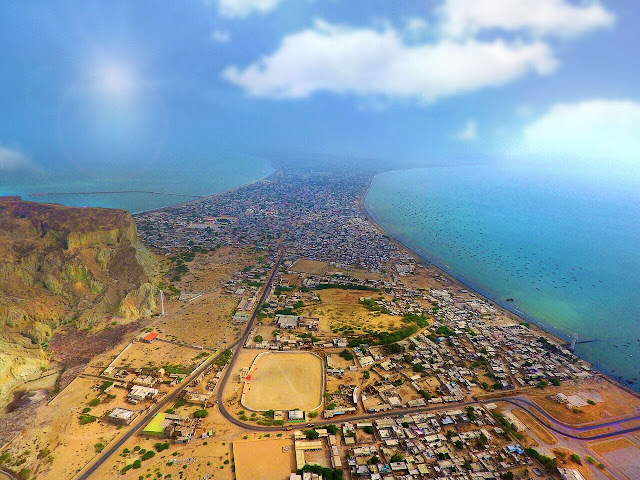PakAlumni Worldwide: The Global Social Network
The Global Social Network
CPEC is Transforming The Least Developed Parts of Pakistan
In a New York Times Op Ed titled "How Not to Engage With Pakistan", ex US Ambassador to Pakistan Richard G. Olson says "Its (CPEC's) magnitude and its transformation of parts of Pakistan dwarf anything the United States has ever undertaken". Olson goes on to warn the Trump Administration that "Without Pakistani cooperation, our (US) army in Afghanistan risks becoming a beached whale".
Among the parts of Pakistan being transformed by China Pakistan Economic Corridor (CPEC) are some of the least developed regions in Balochistan and Sindh, specifically Gwadar and Thar Desert. Here is more on these regions:
Gwadar Port City:
Gwadar is booming. It's being called the next Shenzhen by some and the next Hong Kong by others as an emerging new port city in the region to rival Dubai. Land prices in Gwadar are skyrocketing, according to media reports. Gwadar Airport air traffic growth of 73% was the fastest of all airports in Pakistan where overall air traffic grew by 23% last year, according to Anna Aero publication. A new international airport is now being built in Gwadar to handle soaring passenger and cargo traffic.
In addition to building a major seaport that will eventually handle 300-400 million tons of cargo in a year, China has built a school, sent doctors and pledged about $500 million in grants for an airport, hospital, college and badly-needed water supply infrastructure for Gwadar, according to Reuters.
 |
| 400 Km Long Kachhi Canal From Punjab to Balochistan |
The Chinese grants include $230 million for a new international airport in Gwadar, one of the largest such disbursements China has made abroad, according to researchers and Pakistani officials.
New development work in Gwadar is expected to create as many as 20,000 jobs for the local population.
Steel Bridges on Multan-Qila Saifullah Section of Highway N-70 Conn... |
Thar Desert:
Thar, one of the least developed regions of Pakistan, is seeing unprecedented development activity in energy and infrastructure projects. New roads, airports and buildings are being built along with coal mines and power plants as part of China-Pakistan Economic Corridor (CPEC). There are construction workers and machinery visible everywhere in the desert. Among the key beneficiaries of this boom are Thari Hindu women who are being employed by Sindh Engro Coal Mining Company (SECMC) as part of the plan to employ locals. Highlighted in recent news reports are two Hindu women in particular: Kiran Sadhwani, an engineer and Gulaban, a truck driver.
Kiran Sadhwani, a Thari Hindu Woman Engineer. Source: Express Tribune |
Thar Population:
The region has a population of 1.6 million. Most of the residents are cattle herders. Majority of them are Hindus. The area is home to 7 million cows, goats, sheep and camel. It provides more than half of the milk, meat and leather requirement of the province. Many residents live in poverty. They are vulnerable to recurring droughts. About a quarter of them live where the coal mines are being developed, according to a report in The Wire.
Some of them are now being employed in development projects. A recent report talked of an underground coal gasification pilot project near the town of Islamkot where "workers sourced from local communities rested their heads after long-hour shifts".
In the first phase, Sindh Engro Coal Mining Company (SECMC) is relocating 5 villages that are located in block II. SECMC is paying villagers for their homes and agricultural land.
SECMC’s chief executive officer, Shamsuddin Ahmed Shaikh, says his company "will construct model towns with all basic facilities including schools, healthcare, drinking water and filter plants and also allocate land for livestock grazing,” according to thethirdpole.net He says that the company is paying villagers above market prices for their land – Rs. 185,000 ($ 1,900) per acre.
Summary:
Ex US Ambassador Richard Olson is absolutely right in his assessment that "(CPEC's) magnitude and its transformation of parts of Pakistan dwarf anything the United States has ever undertaken". Olson goes on to warn the Trump Administration that "Without Pakistani cooperation, our (US) army in Afghanistan risks becoming a beached whale". The "magnitude" of CPEC and its "transformation" that Olson refers to is clearly visible in some of the least developed regions of Pakistan in Balochistan and Sindh provinces. Gwadar port city and Thar desert are humming with unprecedented development activity fueled by billions of dollars of funds allocated by China and Pakistan.
Related Links:
-
Comment by Riaz Haq on July 7, 2023 at 7:06pm
-
Chinese companies help in improving social sector
https://www.thenews.com.pk/print/1086783-chinese-companies-help-in-...
Islamabad: Chinese companies have enhanced their role in social development of Pakistan, while addressing the country’s economic and development issues. The companies are an integral part of CPEC. They are the torch bearer of this flagship project of BRI. They are not only helping Pakistan overcome its infrastructure problems but also investing in social development, skills, and environmental protection in Pakistan. All Chinese companies are investing in social development, but only a few have been selected for discussion, a report carried by Gwadar Pro. The Chinese companies not only helped to create thousands of jobs but also invested in building the capacity of hundreds of engineers and staff members.
According to available data, Huaneng Shandong Rui Group, which built the Sahiwal coal power invested in 622 employees for building their capacity and sharpen their skills. Further segregation of data shows that 245 engineers were trained following the need for required skills at plants. Port Qasim also contributed to building the capacity of engineers and staff members. Data shows that 2,600 employees benefited from the capacity-building and skill development opportunities offered by the Port Qasim plant. It trained 600 engineers and 2,000 general staff members.
It is a huge number, especially in the engineering category. It will help Pakistan; as Pakistan has a shortage of qualified and trained engineers. These companies also assisted Pakistan during floods and COVID-19. Second, the Chinese Overseas Port Holding Company (COPHC) is another Chines company, which is investing in social development. The major contribution of COPHC is in the sectors of education, waste management, environmental protection, and the provision of food.
-
Comment by Riaz Haq on July 30, 2023 at 5:30pm
-
The mega undertaking (China-Pakistan Economic Corridor or CPEC) has created nearly 200,000 direct local jobs, built more than 1,400 kilometers (870 miles) of highways and roads, and added 8,000 megawatts of electricity to the national grid, ending years of blackouts caused by power outages in the country of 230 million people.
https://www.voanews.com/a/top-china-official-visits-pakistan-markin...
Chinese Foreign Ministry spokesman Wang Wenbin told reporters in Beijing earlier this month that CPEC projects "are flourishing all across Pakistan," making a "tangible contribution" to the national development of the country and to regional connectivity.
But critics say many projects have suffered delays, including several much-touted industrial zones that were supposed to help Pakistan enhance its exports to earn much-needed foreign exchange.
The country's declining dollar reserves have prevented Islamabad from paying Chinese power producers, leading to strains in many ties.
Pakistan owes more than $1.26 billion (350 billion rupees) to Chinese power plants. The amount keeps growing, and China has been reluctant to defer or restructure the payment and CPEC debts. All the Chinese loans – both government and commercial banks – makeup nearly 30% of Islamabad's external debt.
Some critics blame CPEC investments for contributing to Pakistan's economic troubles. The government fended off the risk of an imminent default by securing a short-term $3 billion International Monetary Fund bailout agreement this month.
Security threats to its citizens and interests in Pakistan have also been a cause of concern for China. Militant attacks have killed several Chinese nationals in recent years, prompting Beijing to press Islamabad to ensure security measures for CPEC projects.
Diplomatic sources told VOA that China has lately directed its diplomats and citizens working on CPEC programs to strictly limit their movements and avoid visiting certain Pakistani cities for security reasons.
"They [Chinese] believe this security issue is becoming an impediment in taking CPEC forward," Senator Mushahid Hussain, the chairman of the defense committee of the upper house of the Pakistani parliament, told VOA in an interview earlier this month.
"Recurring expressions of concern about the safety and security of Chinese citizens and investors in Pakistan by top Chinese leaders indicate that Pakistan's promises of 'foolproof security' for Chinese working in Pakistan have yet to be fulfilled," said Hussain, who represents Prime Minister Shehbaz Sharif's ruling party in the Senate.
Comment
- ‹ Previous
- 1
- …
- 9
- 10
- 11
- Next ›
Twitter Feed
Live Traffic Feed
Sponsored Links
South Asia Investor Review
Investor Information Blog
Haq's Musings
Riaz Haq's Current Affairs Blog
Please Bookmark This Page!
Blog Posts
Pakistanis' Insatiable Appetite For Smartphones
Samsung is seeing strong demand for its locally assembled Galaxy S24 smartphones and tablets in Pakistan, according to Bloomberg. The company said it is struggling to meet demand. Pakistan’s mobile phone industry produced 21 million handsets while its smartphone imports surged over 100% in the last fiscal year, according to …
ContinuePosted by Riaz Haq on April 26, 2024 at 7:09pm
Pakistani Student Enrollment in US Universities Hits All Time High
Pakistani student enrollment in America's institutions of higher learning rose 16% last year, outpacing the record 12% growth in the number of international students hosted by the country. This puts Pakistan among eight sources in the top 20 countries with the largest increases in US enrollment. India saw the biggest increase at 35%, followed by Ghana 32%, Bangladesh and…
ContinuePosted by Riaz Haq on April 1, 2024 at 5:00pm
© 2024 Created by Riaz Haq.
Powered by
![]()





You need to be a member of PakAlumni Worldwide: The Global Social Network to add comments!
Join PakAlumni Worldwide: The Global Social Network